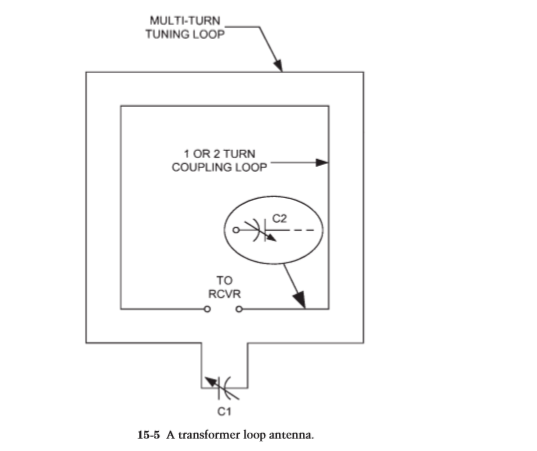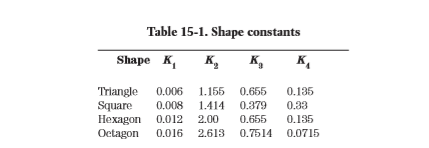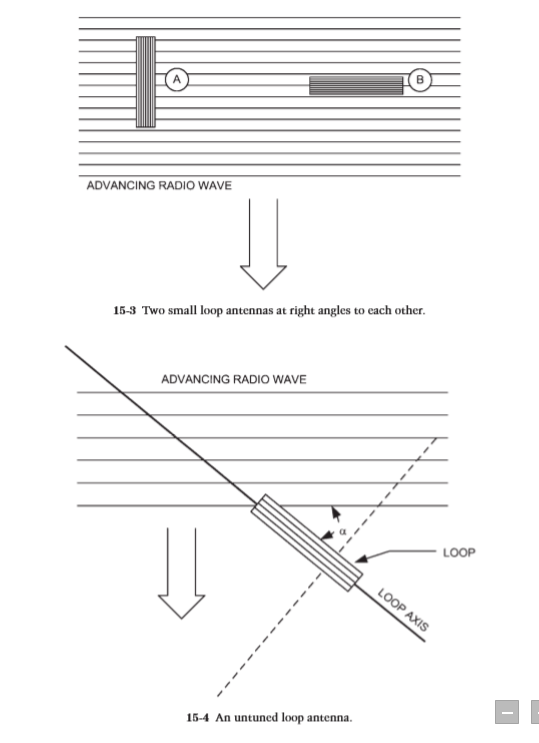It is common practice to make a small loop antenna with two loops rather than just one. Figure 15-5 shows such a transformer loop antenna. The main loop is built exactly as discussed above: several turns of wire on a large frame, with a tuning capacitor to resonate it to the frequency of choice. The other loop is a one- or two-turn coupling loop.This loop is installed in very close proximity to the main loop, usually (but not necessarily) on the inside edge not more than a couple of centimeters away. The purpose of this loop is to couple signal induced from the main loop to the receiver at a more reasonable impedance match. The coupling loop is usually untuned, but in some designs a tuning capacitor (C2) is placed in series with the coupling loop. Because there are many fewer turns on the coupling loop than on the main loop, its inductance is considerably smaller. As a result, the capacitance to resonate is usually much larger. In several loop antennas constructed for purposes of researching this chapter,
I found that a 15-turn main loop resonated in the AM BCB with a standard 365-pF capacitor, but the two-turn coupling loop required three sections of a ganged 3 365-pF capacitor connected in parallel to resonate at the same frequencies. In several experiments, I used computer ribbon cable to make the loop turns. This type of cable consists of anywhere from 8 to 64 parallel insulated conductors arranged in a flat ribbon shape. Properly interconnected, the conductors of the ribbon cable form a continuous loop. It is no problem to take the outermost one or two conductors on one side of the wire array and use them for a coupling loop.
Find the best antennas for TV, radio, and wireless. Compare top antenna deals, use free antenna calculators, follow DIY guides, and buy high-performance antennas with confidence.
Air core frame loops (“box” loops)
A wire loop antenna is made by winding a large coil of wire, consisting of one or more turns, on some sort of frame. The shape of the loop can be circular, square, triangular, hexagonal, or octagonal. For practical reasons, the square loop seems to be most popular. With one exception, the loops considered in this section will be square, so you can easily duplicate them. The basic form of the simplest loop is shown in Fig. 15-2. This loop is square, with sides the same length A all around. The width of the loop (B) is the distance from the first turn to the last turn in the loop, or the diameter of the wire if only one turn is used. The turns of the loop in Fig. 15-2 are depth wound, meaning that each turn of the loop is spaced in a slightly different parallel plane. The turns are spaced evenly across distance B. Alternatively, the loop can be wound such that the turns are in the same plane (this is called planar winding). In either case, the sides of the loop (A) should be not less than five times the width (B). There seems to be little difference between depth- and planar-wound loops. The far-field patterns of the different shape loops are nearly the same if the respective cross-sectional areas ( r2 for circular loops and A2 for square loops) are less than 2/100. The reason why a small loop has a null when its broadest aspect is facing the signal is simple, even though it seems counterintuitive at first blush. Take a look at Fig. 15-3. Here, we have two identical small loop antennas at right angles to each other. Antenna A is in line with the advancing radio wave, whereas antenna B is broadside to the wave. Each line in the wave represents a line where the signal strength is the same, i.e., an “isopotential line.” When the loop is in line with the signal (antenna A), there is a difference of potential from one end of the loop to the other, so current can be induced in the wires. When the loop is turned broadside, however, all points on the loop are on the same potential line, so there is no difference of potential between segments of the conductor. Thus little signal is picked up (and the antenna therefore sees a null). The actual voltage across the output terminals of an untuned loop is a function of the angle of arrival of the signal (Fig. 15-4), as well as the strength of the signal and the design of the loop. The voltage Vo is given by
Even though the output signal voltage of tuned loops is higher than that of untuned loops, it is nonetheless low compared with other forms of antenna. As a result, a loop preamplifier usually is needed for best performance.
Even though the output signal voltage of tuned loops is higher than that of untuned loops, it is nonetheless low compared with other forms of antenna. As a result, a loop preamplifier usually is needed for best performance.
Small loop receiving antennas
These antennas are fundamentally different from large loops and other sorts of antennas used in these bands. Large loop antennas have a length of at least 0.5 , and most are quite a bit larger than 0.5 . Small loop antennas, on the other hand, have an overall length that is less than 0.22 , with most being less than 0.10 .
The small loop antenna responds to the magnetic field component of the electromagnetic wave instead of the electrical field component. One principal difference between the large loop and the small loop is found when examining the RF currents induced in a loop when a signal intercepts it.
In a large loop, the current will vary from one point in the conductor to another, with voltage varying out of phase with the current. In the small loop antenna, the current is the same throughout the entire loop.
The differences between small loops and large loops show up in some interesting ways, but perhaps the most striking is the directions of maximum response—the main lobes—and the directions of the nulls.
Both types of loops produce figure-8 patterns but in directions at right angles with respect to each other. The large loop antenna produces main lobes orthogonal,at right angles or “broadside,” to the plane of the loop. Nulls are off the sides of the loop.
The small loop, however, is exactly the opposite: The main lobes are off the sides of the loop (in the direction of the loop plane), and the nulls are broadside to the loop plane (Fig. 15-1A). Do not confuse small loop behavior with the behavior of the loopstick antenna.
Loopstick antennas are made of coils of wire wound on a ferrite or powdered-iron rod. The direction of maximum response for the loopstick antenna is broadside to the rod, with deep nulls off the ends (Fig. 15-1B). Both loopsticks and small wire loops are used for radio direction-finding and for shortwave, low-frequency medium-wave, AM broadcast band, and VLF listening.
The nulls of a loop antenna are very sharp and very deep. Small changes of pointing direction can make a profound difference in the response of the antenna. If you point a loop antenna so that its null is aimed at a strong station, the signal strength of the station appears to drop dramatically at the center of the notch.
The nulls of a loop antenna are very sharp and very deep. Small changes of pointing direction can make a profound difference in the response of the antenna. If you point a loop antenna so that its null is aimed at a strong station, the signal strength of the station appears to drop dramatically at the center of the notch.
Turn the antenna only a few degrees one way or the other, however, and the signal strength increases sharply. The depth of the null can reach 10 to 15 dB on sloppy loops and 30 to 40 dB on well-built loops (30 dB is a very common value). I have seen claims of 60-dB nulls for some commercially available loop antennas.
The construction and uniformity of the loop are primary factors in the sharpness and depth of the null.
At one time, the principal use of the small loop antenna was radio direction-finding, especially in the lower-frequency bands. The RDF loop is mounted with a compass rose to allow the operator to find the direction of minimum response. The null was used, rather than the peak response point, because it is far narrower than the peak.
At one time, the principal use of the small loop antenna was radio direction-finding, especially in the lower-frequency bands. The RDF loop is mounted with a compass rose to allow the operator to find the direction of minimum response. The null was used, rather than the peak response point, because it is far narrower than the peak.
As a result, precise determination of direction is possible. Because the null is bidirectional, ambiguity exists as to which of the two directions is the correct direction. What the direction-finder “finds” is a line along which the station exists. If the line is found from two reasonably separated locations and the lines of direction are plotted on a map, then the two lines will cross in the area of the station. Three or more lines of direction (a process called triangulation) yields a pretty precise knowledge of the station’s actual location.
Today, these small loops are still used for radio direction-finding, but their use has been extended into the general receiving arena, especially on the low frequencies. One of the characteristics of these bands is the possibility of strong local interference smothering weaker ground-wave and sky-wave stations.
As a result, you cannot hear cochannel signals when one of them is very strong and the other is weak. Similarly, if a cochannel station has a signal strength that is an appreciable fraction of the desired signal and is slightly different in frequency, then the two signals will heterodyne together and form a whistling sound in the receiver output.
The frequency of the whistle is an audio tone equal to the difference in frequency between the two signals. This is often the case when trying to hear foreign BCB signals on frequencies (called split frequencies) between the standard spacing. The directional characteristics of the loop can help if the loop null is placed in the direction of the undesired signal.
Loops are used mainly in the low-frequency bands even though such loops are either physically larger than high-frequency loops or require more turns of wire. Loops have been used as high as VHF and are commonly used in the 10-m ham band for such activities as hidden transmitter hunts.
The reason why low frequencies are the general preserve of loops is that these frequencies are more likely to have substantial ground-wave signals. Sky-wave signals lose some of their apparent directivity because of multiple reflections.
Similarly, VHF and UHF waves are likely to reflect from buildings and hillsides and so will arrive at angles other than the direction of the transmitter. As a result, the loop is less useful for the purpose of radio directionfinding.
If your goal is not RDF but listening to the station, this is hardly a problem. A small loop can be used in the upper shortwave bands to null a strong local groundwave station in order to hear a weaker sky-wave station.
Finally, loops can be useful in rejecting noise from local sources, such as a “leaky” electric power line or a neighbor’s outdoor light dimmer. Let’s examine the basic theory of small loop antennas and then take a look at some practical construction methods.
Grover’s equation
Grover’s equation (Grover, 1946) seems closer to the actual inductance measured in empirical tests than certain other equations that are in use. This equation is
n is the number of turns in the loop
K1through K4 are shape constants and are given in Table 15-1
ln is the natural log of this portion of the equation
Grover’s equation
Grover’s equation (Grover, 1946) seems closer to the actual inductance measured in empirical tests than certain other equations that are in use. This equation is
n is the number of turns in the loop
K1through K4 are shape constants and are given in Table 15-1
ln is the natural log of this portion of the equation
(source : Practical Antenna Handbook by Joseph J. Carr )
Half Delta Sloper (HDS) Antenna
The half-delta sloper (HDS) antenna (Fig. 14-9) is similar to the full delta loop, except that (like the quarter-wavelength vertical) half of the antenna is in the form of an “image” in the ground. Gains of 1.5 to 2 dB are achievable. The HDS antenna consists of two elements: a /3-wavelength sloping wire and a /6 vertical wire (on an insulated mast), or a /6 metal mast.
Because the ground currents are very important, much like the vertical antenna, either an extensive radial system at both ends is needed, or a base ground return wire (buried) must be provided. The HDS will work on its design frequency, plus harmonics of the design frequency. For a fundamental frequency of 5 MHz, a vertical segment of 33 ft and a sloping section of 66 ft is needed. The lengths for any frequency are found from
The HDS is fed at one corner, close to the ground. If only the fundamental frequency is desired, then you can feed it with 52-Ω coaxial cable. But at harmonics, the feedpoint impedance changes to as high as 1000 Ω. If harmonic operation is intended, then an antenna tuning unit (ATU) is needed at point A to match these impedances.
Bisquare Loop Antenna
The bisquare antenna - The bisquare antenna offers as much as 4-dB gain broadside to the plane of the antenna (i.e., in and out of the book page), in a figure-8 pattern, on the design frequency. It is horizontally polarized. When the frequency drops to one-half of the design frequency, the gain drops to about 2 dB, and the antenna works like the diamond loop covered previously.shown in Fig. 14-10, is similar to the other large loops, except that it is /2 on each side, making a total wire length of two wavelengths. This antenna is built like the diamond loop shown earlier (i.e., it is a large square loop fed at an apex that is set at the bottom of the assembly). In this case, the loop is fed either with an antenna tuning unit (to match a 1000-Ωimpedance) or a quarter-wavelength matching section made of 300-Ω or 450-Ω twin-lead transmission line. A 1:1 balun transformer connects the 75-Ω coaxial cable to the matching section. the bi-square is not quite a real loop since it is split at the top.
The bi-square antenna offers as much as 4-dB gain broadside to the plane of the antenna (i.e., in and out of the book page), in a figure-8 pattern, on the design frequency. It is horizontally polarized. When the frequency drops to one-half of the design frequency, the gain drops to about 2 dB, and the antenna works like the diamond loop covered previously.
For bi-square Antenna many prefer use coaxial cable to the 300 ohm ribbon feedline to the bi-square normally uses.
Still, if you have one tall tower (at least 3/4 wavelength high) the bi-square may be worth considering. It's basically a bidirectional gain antenna. If you've already got the wire the construction cost is low. And you may be able to use some ingenious remote switching with relays to change the antenna into a large loop for other bands.
Another example project The Bi-Square antenna with four half-waves in phase, which makes it three half-waves and about 4 db better than dipole. The Bi-square to be described is for 15 meters , also success used for 20m and 40m band.
The advantages of this antenna are many. It's cheap , you need only one pole, 35 feet or over, to hang it on. It is bi-directional . you can hang two of them on one pole and cover 360 degrees. It's easy to tune. It has 4 dB Gain, which puts it in the well tuned two-element beam class. It is also good competition for the "pre-tuned" or untuned three-element beam. This Bi-square antenna can feed in to 150 watt Sideband Transmitter.
Reference : Practical Antenna handbook - Joseph J. Carr
Subscribe to:
Comments (Atom)












